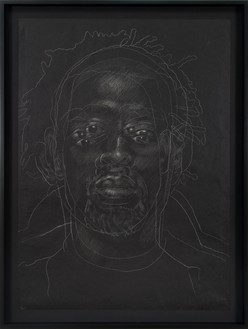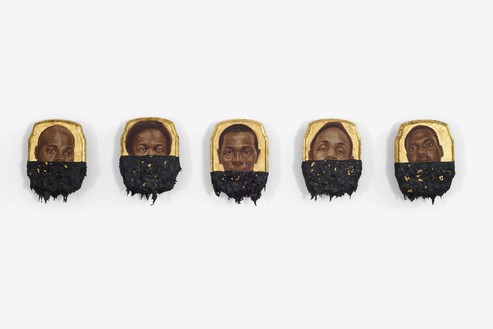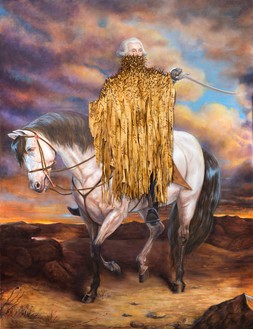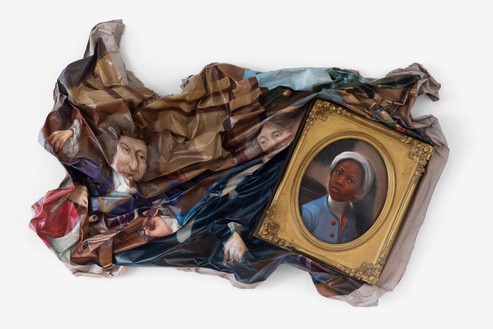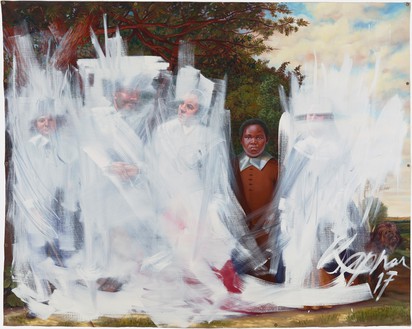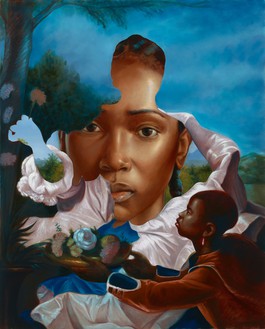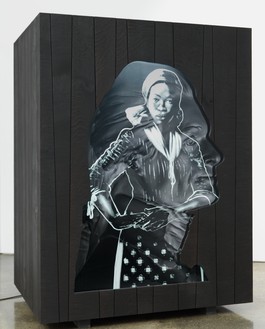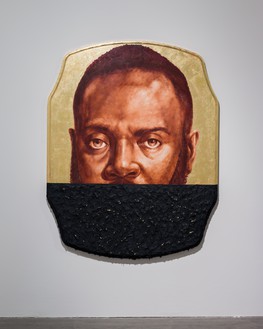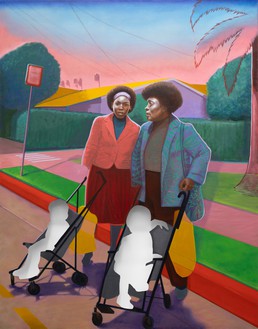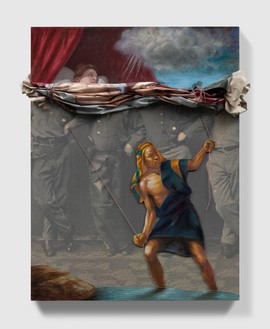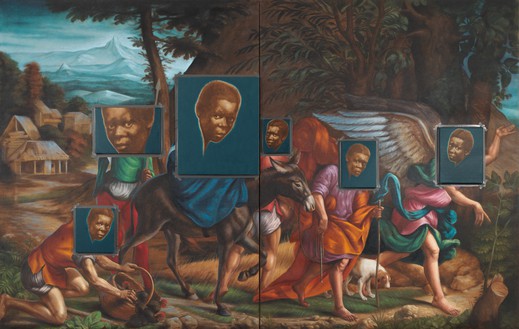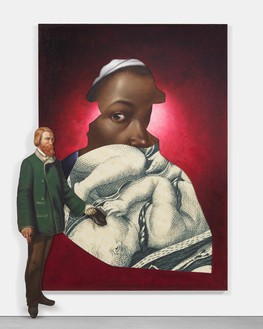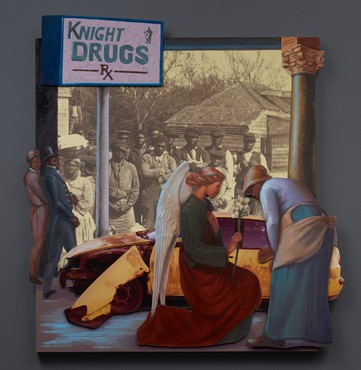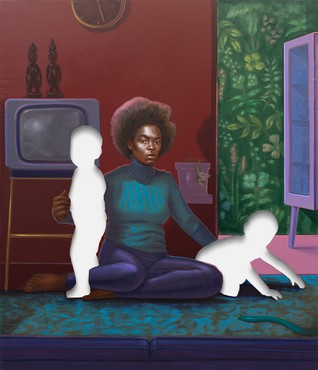About
If we don’t amend history by making new images and new representations, we are always going to be excluding ourselves.
—Titus Kaphar
Painter, sculptor, filmmaker, and installation artist Titus Kaphar confronts history by dismantling classical structures and styles of visual representation in Western art in order to subvert them. Dislodging entrenched narratives from their status as “past” so as to understand and estimate their impact on the present, he exposes the conceptual underpinnings of contested nationalist histories and colonialist legacies and how they have served to manipulate both cultural and personal identity.
Through the deconstructive techniques of cutting, shredding, stitching, binding, and erasing both subject and support, Kaphar reconstructs new codes and modalities, reckoning on Black possibilities. In Yet Another Fight for Remembrance (2014), he used thick white brushstrokes to obscure the gesturing bodies of a group of African American men in the “Hands up, don’t shoot” position, and then repainted their outlines in black to reassert their formal presence. Thus the painting process itself became the embodiment of the ongoing struggle for social visibility and recognition. During his 2017 TED Talk, Kaphar performed, onstage, the whitewashing of his large-scale painting Shifting the Gaze (2017). Based on Frans Hals’s Family Group in a Landscape (1645–48), which portrays a wealthy Dutch family and their African servant, Kaphar’s version eclipsed the family group with white paint, shifting attention entirely to the presence of this young servant.
Kaphar’s art addresses salient social and political concerns, but it also springs from his own life story. For example, his encounter with his estranged father, Jerome, has led to an ongoing multimedia exploration of the criminal justice system called The Jerome Project (2014–). This series of portraits began with Kaphar’s online discovery of the mug shots of ninety-seven African American men who shared his father’s first and last names. He paints gilded portraits of each man in the style of Byzantine devotional icons, and then dips them in tar. Initially, the depth to which each painting was immersed in tar corresponded to the time that each subject had spent behind bars; in later paintings, this has increased to represent the longer-term implications of social silencing that results from their incarceration.

Photo: John Lucas
#TitusKaphar
Website
Exhibitions

NXTHVN: Curatorial Visions
Jamillah Hinson and Marissa Del Toro, recent curatorial fellows of Titus Kaphar’s nonprofit community arts hub NXTHVN, address their curatorial praxes.
In Conversation
Titus Kaphar and Zoé Whitley
Join Titus Kaphar and Zoé Whitley as they discuss the artist’s recent exhibition New Alte̲rs: Reworking Devotion, featuring paintings and sculptures in which Kaphar examines the history of representation by altering the work’s supports to reveal oft unspoken social and political truths.
NXTHVN
NXTHVN is a new national arts model that empowers emerging artists and curators of color through education and access. Through intergenerational mentorship, professional development, and cross-sector collaboration, NXTHVN accelerates professional careers in the arts. Join Titus Kaphar and Jason Price on a tour of the organization’s headquarters in New Haven, Connecticut. They discuss the founding and vision for this singular arts space.
Titus Kaphar: From a Tropical Space
Join the artist in his studio in New Haven, Connecticut, where he speaks about his latest paintings.
Titus Kaphar: Can Beauty Open Our Hearts to Difficult Conversations?
In this TED talk, presented during the sweeping protests against racism and police violence following the killing of George Floyd, Titus Kaphar describes how the beauty of a painting can draw the viewer in and allow difficult conversations to emerge. Kaphar discusses his own work and shares the idea behind NXTHVN, a new national arts model he founded to empower artists of color through education and access.

Seeing the Child: Braiding possibility
Titus Kaphar and Tochi Onyebuchi present an excerpt from their short story “Seeing the Child,” a poetic rumination on Kaphar’s latest body of work, From a Tropical Space (2019–).

Titus Kaphar: In the Studio
Jacoba Urist reports on a recent trip to the artist’s studio in New Haven, Connecticut, to see his new body of work, From a Tropical Space (2019–). She writes on the emotional and sensory impact of these paintings and considers their singular place in Titus Kaphar’s oeuvre.

Titus Kaphar: Intricate Illusion
Bridget R. Cooks investigates the aesthetic and narrative conventions deployed by the artist, demonstrating how his paintings force provocative confrontations with history through complex modes of depiction.
Titus Kaphar: Can Art Amend History?
Join Titus Kaphar as he talks about making paintings and sculptures that wrestle with the struggles of the past while speaking to the diversity and advances of the present. Working onstage, he points to the narratives coded in the language of art history as he creates a new painting, demonstrating how shifting our focus can prompt us to ask questions and confront unspoken truths.
Fairs, Events & Announcements
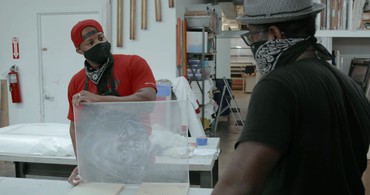
Screening and Talk
Titus Kaphar
Derek Cianfrance
Friday, April 28, 2023, 7pm
Metrograph, New York
metrograph.com
Join Titus Kaphar and director Derek Cianfrance on the opening night of Titus Kaphar Selects, a film program curated by the artist as part of a series copresented by Gagosien and Metrograph. The evening will include screenings of Kaphar’s short films Shut Up and Paint, an Oscar-shortlisted work in which he looks to the medium of film in the face of an insatiable art market seeking to silence his activism, and I Hold Your Love, a New Yorker documentary that explores the joys and injustices of Black motherhood. Following the screenings, the pair will speak about their respective practices and work, including Cianfrance’s 2010 film Blue Valentine, which also features in the program.
Still from Shut Up and Paint (2022), directed by Titus Kaphar and Alex Mallis
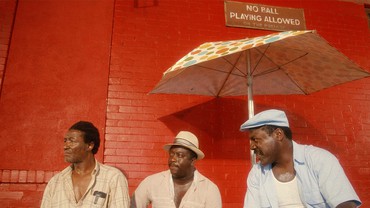
Screening
Titus Kaphar Selects
April 28–May 11, 2023
Metrograph, New York
metrograph.com
Titus Kaphar has curated a selection of films as part of a series copresented by Gagosien and Metrograph. The program features seven films that have each served to validate feelings of joy, pain, fear, or sorrow for the artist, as well as two short films that he directed.
Kaphar explains, “Film is a uniquely powerful medium. Its ability to tap into our emotions is unlike anything else for me. This is not a top ten list. This is a decidedly subjective selection of films that, through their vulnerability and specificity, have made me feel less alone.”
Featured films include
The Babadook
Blue Valentine
Boyz n the Hood
Do the Right Thing
Drive My Car
I Hold Your Love
The Last Black Man in San Francisco
Moonlight
Shut Up and Paint
Still from Do the Right Thing (1989), directed by Spike Lee
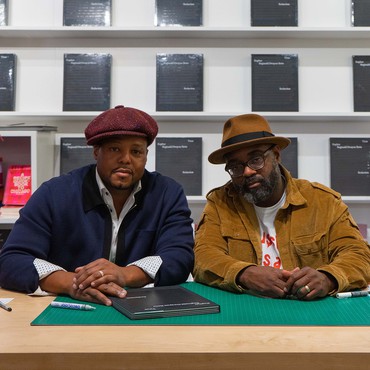
Reading and Book Signing
Titus Kaphar and Reginald Dwayne Betts
Redaction
Wednesday, March 22, 2023, 6–7pm
Gagosien Shop, New York
In celebration of their new book, Redaction, Titus Kaphar and memoirist, poet, and attorney Reginald Dwayne Betts will sign copies, following a poetry reading by Betts. The volume documents the pair’s Redaction series, first presented in 2019 at MoMA PS1, New York. Bringing together poetry by Betts that draws upon redacted legal documents and Kaphar’s etched portraits of incarcerated individuals, the project exposes the ways in which the legal system exploits and erases the poor and incarcerated from public consciousness. Redaction was designed in close collaboration with Kaphar and Betts and also includes an introduction by Sarah Suzuki, associate director at the Museum of Modern Art, New York. Published by W. W. Norton & Company, the book will be available for purchase at the event.
Titus Kaphar and Reginald Dwayne Betts signing copies of their book Redaction at the Gagosien Shop, New York, 2023. Photo: Mauricio Zelaya
Museum Exhibitions

On View
New Symphony of Time
Opened September 7, 2019
Mississippi Museum of Art, Jackson
www.msmuseumart.org
New Symphony of Time expands the boundaries of Mississippi’s identity, casting light on a shared past to help reflect an expansive, more inclusive future. The exhibition aims to explore personal and collective memory, history and the connection to place, and the roles artists play in pursuit of civil rights and racial equity through ancestry. Themes include migration, movement, and home; shared humanity; environment; and liberty. Work by Titus Kaphar and Sally Mann is included.
Sally Mann, Deep South, Untitled (Emmett Till River Bank), 1998 © Sally Mann

Closed
Black American Portraits
February 8–June 30, 2023
Spelman College Museum of Fine Art, Atlanta
museum.spelman.edu
Remembering Two Centuries of Black American Art, guest curated by David Driskell at the Los Angeles County Museum of Art in 1976, Black American Portraits reframes portraiture to center Black American subjects, sitters, and spaces. Spanning more than two centuries from circa 1800 to the present day, this selection of approximately 140 works draws primarily from LACMA’s permanent collection and chronicles the ways in which Black Americans have used portraiture to envision themselves in their own eyes. Countering a visual culture that often demonizes Blackness and fetishizes the spectacle of Black pain, these images center love, abundance, family, community, and exuberance. This exhibition has traveled from the Los Angeles County Museum of Art. Work by Titus Kaphar and Nathaniel Mary Quinn is included.
Nathaniel Mary Quinn, Uncle Dope, 2017 © Nathaniel Mary Quinn. Photo: Michael Tropea

Closed
No Justice without Love
April 4–June 30, 2023
Ford Foundation Gallery, New York
www.fordfoundation.org
No Justice without Love brings together the transformational work of artists, activists, and allied donors who make up the Art for Justice Fund community. The exhibition is an invitation to engage with the Fund’s mission to change the narrative around mass incarceration and disrupt the criminal justice system. In charting the evolution of artists’ practices, the works on show point to the ways in which artists and advocates create new aesthetics around humanity, resilience, and self-determination, while elevating themes of redemption, rehabilitation, and transformation. Work by Titus Kaphar and Stanley Whitney is included.
Installation view, No Justice without Love, Ford Foundation Gallery, New York, April 4–June 30, 2023. Artwork, left to right: © Stanley Whitney, © Sherrill Roland. Photo: Sebastian Bach
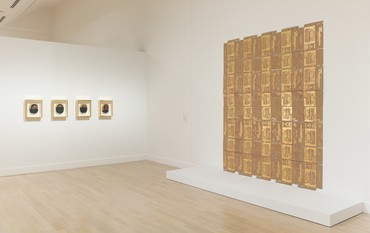
Closed
Titus Kaphar in
Gilded: Contemporary Artists Explore Value and Worth
September 10, 2022–April 8, 2023
Weatherspoon Art Museum, University of North Carolina, Greensboro
weatherspoonart.org
Gilded: Contemporary Artists Explore Value and Worth explores the use of gold leaf in contemporary works of art. The artists represented in this exhibition have turned to gilding as a means of reconsidering our value systems. Applying gold to images of graffiti and sidewalks, cardboard boxes, and architectural fragments, they ask us to honor and see the beauty in things that are so often overlooked or discarded. Gilding images of people—often those who have been disempowered or forgotten—they ask us to pay respect to our collective humanity. Work by Titus Kaphar is included.
Installation view, Gilded: Contemporary Artists Explore Value and Worth, Weatherspoon Art Museum, University of North Carolina, Greensboro, September 10, 2022–April 8, 2023. Artwork, left to right: © Titus Kaphar, © Danh Vo


